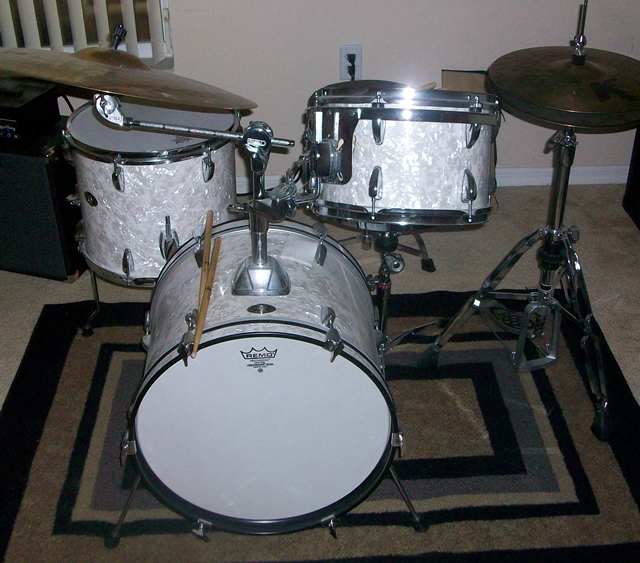Before proceeding, here are a few caveats:
- I play a narrow set of genres - mainly jazz and blues
- My preferred sound is open and minimally muffled
- The only heads I am going to discuss are ones with which I've had direct and extensive experience
First up is my workhorse heads - Remo Coated Ambassadors.
I use these on everything - snare batters, and tom and bass drum batters and resonants. Let's start with why I love them on snare drums: For snare drum batter heads I have tried every other head on the market and the Remo coated Ambassador has the resonance, warmth and for snare drums, the right texture, that I want in a drum head. Bear in mind that I play a lot of acoustic jazz and like my drums to be open sounding. Also, I have found that when paired with a hazy Diplomat on the snare side I get superb response.
Regarding the texture - there are certain Aquarian models that have better texture for brush playing, but sound too plastic like with sticks. My solution is to take some 400 grit sand paper and lightly (very lightly) pass over the surface. This smooths the rough spots without starting a wear spot that will prematurely shorten the head's life. Note: This head will not fit some vintage drums, which I will address further on, and also will not fit Premier drums in metric sizes. Remo has a model especially for those: BA-0114-PR. In fact, if you replace the "00" with a "PR" in Remo part numbers you will get the model number for heads that fit the metric sized Premiers.
Since I play mostly 20" bass drum, 12" and 14" toms or the same configuration with 18" bass drums, I also use 12" coated Ambassadors for my rack toms (the 14" snare head works on my floor tom) and either the 18" coated Ambassador or the 20" model on my bass drums.
Like my toms, I use the heads on both the batter and resonant sides. For me this configuration is not only excellent for old school blues, but perfect for jazz. I do not stuff anything into the bass drum, and, in fact, usually use a single felt strip (depending on the room.) The resonance and warmth this head provides is amazing. On every bass drum, from the lower end Tama and Gretsch, to my custom made one, this head emits a note instead of a thud. Of course, my muffling and tuning approaches have a lot to do with that, but still, this is a sound that you are not going to get from pre-muffled heads, or even film batters and resos.

 The Snare drum is a very unique one that was custom made using 1930s Radio King parts and a magnesium shell. The engraved hoops required Aquarian American Vintage heads
The Snare drum is a very unique one that was custom made using 1930s Radio King parts and a magnesium shell. The engraved hoops required Aquarian American Vintage heads Remo also sells convenient prepacks of these heads in various configurations: 10, 12, 14 and 14 (for the snare drum), as well as a 12, 13, and 16 pack for toms but no snare drum.
Before continuing with modern heads I want to address the snare drum head shown in the photo above because if you have vintage drums this one is important. The head brand and model are Aquarian American Vintage (not shown is the snare-side companion.This head was designed specifically to fit vintage American snare drums. The reason I am emphasizing 'American' is because other vintage drums, like Premiers, may use metric sizes in which case this head will not work.
The reason this head is needed is because circa 1900s-1930s and even later snare drums were made slightly oversized by today's sizing standards. For example, the vintage 14" diameter drums were really 14" whereas modern snare drums cited as 14" are really 13.85. To confuse the issue, the above applies mostly to wood snare drums. In my experience, modern heads seem to fit most metal snare drums from the same vintage eras. Still, I am citing rules of thumb and not hard and fast facts because there are always going to be exceptions.
Also note that some late 1800s through early 1900s snare drums - regardless of material - were such off sizes that your only recourse is to have custom heads made for them. Measure first before ordering!
There is a lot to like about this head. The slightly yellowed vintage surface is a nice touch. The texture is beautiful for brushwork. And, of course, the fact that it allows you to play a vintage snare drum that would otherwise be sitting in a display because of heads is the best thing to like. However, to my ears this head has a plastic-like sound when played with sticks. Bear in mind that is the way I personally hear it, and you may not have the same impression. Also, in a live playing situation that sound disappears into the mix.
Aquarian did the vintage drum world a great service with this series because prior to these your only option was to have heads custom made. Or display the snare drum in a case. The first option was expensive (breathtakingly so, in fact), and the second option was a waste of an instrument that survived through the years and deserved to be heard. Aquarian makes a full range of sizes in this series, so if you are outfitting an entire drum kit you may find this to be the best solution.
In my next post I will cover the other heads I use, which are the Fiberskyn series I have on some of my snare drums and one of my drum kits, and the Remo Skyntone, which I have started using on my snare drums.
No comments:
Post a Comment